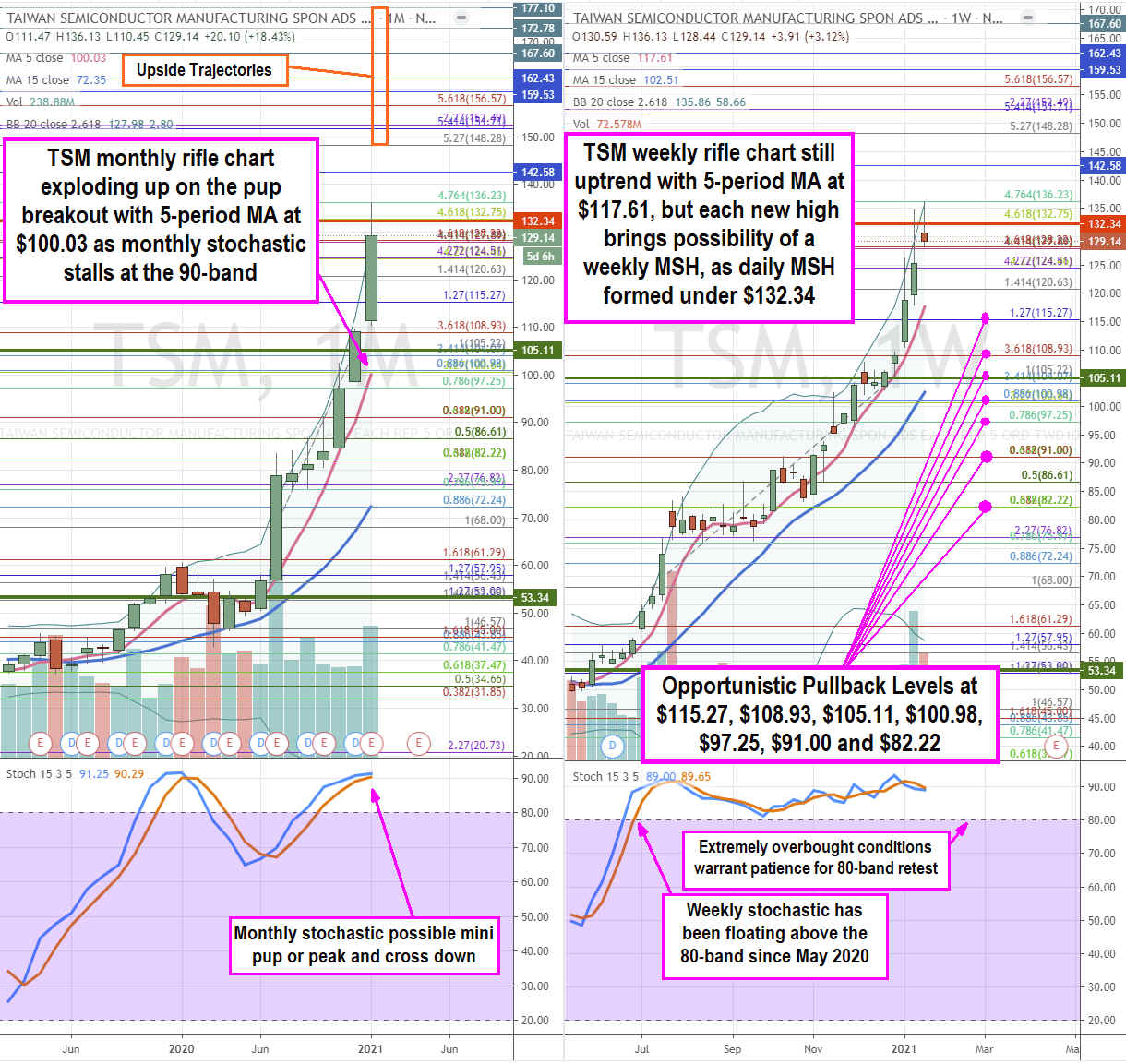
Semiconductor chip maker
Taiwan Semiconductor Manufacturing Company NYSE: TSM stock has been on a near parabolic ascent as the fabless trend continues to gain momentum. Taiwan Semi is the world’s largest chip maker where some of the largest technology companies outsource the manufacturing of their chips. Why invest billions in a chip making foundry, when you can design the chip and then outsource it to a manufacturer for a fraction of the cost? With high profile clients like
Apple NASDAQ: AAPL,
Broadcom NASDAQ: AVGO and
Advanced Micro Devices NYSE: AMD, Taiwan Semi owns a 54% market share of the world’s chip making capacity with
Samsung Electronics OTCMKTS: SSNLF at a distant second place with 17%. The world’s
demand for semiconductors is fueled by the momentum in growth trends including
5G, artificial intelligence (AI) , renewable energy ,
cryptocurrency mining,
electric vehicles (EVs), wireless, wearables and so forth. With shares up over 18% year-to-date (YTD), prudent investors should watch for opportunistic pullback levels to consider taking positions in this core semiconductor play.
Q4 FY 2020 Earnings Release
On Jan. 14, 2021, Taiwan Semi released its fiscal fourth-quarter 2020 results for the quarter ending December 2020. The Company reported an earnings-per-share (EPS) profit of NT$5.51 excluding non-recurring items versus consensus analyst estimates of NT$4.50, a NT$1.01 beat. Revenues rose 14% year-over-year (YoY) to NT$361.5 billion beating analyst estimates of NT$330.47 billion. The Company raised its fiscal Q1 2021 guidance for revenues of $12.70 billion to $13.00 billion versus consensus analyst estimates of $12.32 billion. Gross profit margins are expected between 50.% to 52.5%. Operating profit margin is expected between 39.5% to 41.5%. The Company expects capex to range between $25 billion to $28 billion.
Conference Call Takeaways
Taiwan Semi VFO, Wendall Huang provided color on the quarter, “Our utilization rate in the fourth quarter was at an extremely high level, partially due to more production out of which some of the wafers will be shipped in the first quarter.” Strong demand in 5 nanometer technology was driven by 5G smartphone launches, contributing 20% of wafer revenues in Q4. The 7 nanometer and 15 nanometer wafers contributed 29% and 13%, respectively. Advanced Technologies, 16 nanometer envelope, accounted for 58% of total full-year wafer revenues, up 50% YoY. Smartphone chip demand grew 13% quarter-over-quarter (QoQ) accounting for 51% of Q4 revenues. High performance computing (HPC) and IoT both decreased 13% and 7% but accounted for 31% and 7% of total Q4 revenues. Automotive increased by 27% and Digital consumer electronics rose 29%, to account for 3% and 4% of revenues respectively. The Company ended the quarter with NT$791 billion in cash and marketable securities. In 2020, the Company spent $17.2 billion in capex to support the customer’s capacity needs. To continue to meet the capacity needs of customers, the Company raised its 2021 capex spend to $25 billion to $28 billion. Most of the capex (80%) spend will focus on advanced process technologies including the 3 nanometer, 5 nanometer and 7 nanometer wafers.
Strongest Growth Industries
The strongest growth expected from advanced and specialty technologies, which are four platforms including smart phone, HPC, automotive and IoT. Global smartphone units are expected to grow 10% YoY but the penetration rate of 5G smartphones of total smartphone market is expected to grow from 18% in 2020 to 35% in 2021. CEO, Dr. C.C. Wei, summed up the year, “Concluding 2020, the semiconductor industry, excluding memory recourse, was about 10%, while foundry industry increased 20% YoY. Taiwan Semi’s revenue grew 31.4% YoY in U.S. dollar term.” Dr. Wei sees recovery in the automotive sector in 2021. Dr. Wei summed it up, “Looking ahead, we expect the supply chain and our customer to prepare a higher level of inventory compared to the historical season level for a longer period of time, given the industry’s continued need to ensure supply security.” Dr. Wei sees 2021 semiconductor industry to grow 8% YoY and foundry to grow 10%, but Taiwan Semi should outpace the industry growth seeking mid-teen percentages in U.S. dollar terms in 2021.
Pending Catalysts
Taiwan Semi is at the top of the mountain, but that also makes it a target for competitors. On Jan. 22, 2021, Samsung announced plans to build a $10 billion chip fab in Austin, Texas. The fab would be capable of producing 3 nanometer wafters with construction expected to be completed and operating in 2023. Rumors of Intel outsourcing more chip production were dampened when new incoming CEO stated they would keep most chip production in-house. This was offset by rumors of Apple creating their own chips, which would be possible by outsourcing to Taiwan Semi. Prudent investors can watch for deeper pullbacks to consider exposure in this core semiconductor play.

TSM Opportunistic Pullback Levels
Using the rifle charts on the monthly and weekly time frames provides a broader view of the playing field for TSM shares. The monthly rifle chart formed a pup breakout grinding into a parabolic uptrend that initially peaked off the $138.23 Fibonacci (fib) level. The monthly 5-period moving average (MA) is still trying to catch up near the $100.98 fib. The monthly upper Bollinger Bands (BBs) sit at $127.98. The monthly stochastic stalled around the 90-band which suggests a potential pullback and then a mini pup thrust higher or a cross down for deeper pullbacks. The weekly rifle chart formed a potential shooting star after triggering the mini pup breakout on market structure low (MSL) buy trigger above $105.11. Keep in mind the weekly stochastic has been overbought above the 80-bands since May 2020. Any high band entry has the potential for deep pullbacks when the stochastic eventually falls back below the 80-band. The daily formed a market structure high (MSH) sell trigger below the $132.34 level. The weekly shooting star can form a MSH sell trigger if a lower high candle follows, which would then use the low of that candle as the trigger. If the weekly MSH trigger forms, then prudent investors can watch for opportunistic pullback levels at the $115.27 fib, $105.11 weekly MSL trigger, $100.98 monthly 5-period MA/fib, $97.25 fib, $91.00 fib, and the $82.22 fib. The upside trajectories range from the $148.28fib up towards the $177.10 fib level.
Before you consider Taiwan Semiconductor Manufacturing, you'll want to hear this.
MarketBeat keeps track of Wall Street's top-rated and best performing research analysts and the stocks they recommend to their clients on a daily basis. MarketBeat has identified the five stocks that top analysts are quietly whispering to their clients to buy now before the broader market catches on... and Taiwan Semiconductor Manufacturing wasn't on the list.
While Taiwan Semiconductor Manufacturing currently has a "Moderate Buy" rating among analysts, top-rated analysts believe these five stocks are better buys.
View The Five Stocks Here
Wondering what the next stocks will be that hit it big, with solid fundamentals? Click the link below to learn more about how your portfolio could bloom.
Get This Free Report